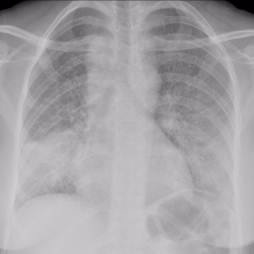EMBARGOED FOR RELEASE | March 26, 2012
Two drugs already on the market show promise against tuberculosis
Note to journalists: Please report that this research was presented at a meeting of the American Chemical Society
A press conference on this topic will be held at 4:30 p.m. Eastern Time, March 26, 2012, in the ACS Press Center, Room 15A, in the San Diego Convention Center. Reporters can attend in person or access live audio and video of the event and ask questions at www.ustream.tv/channel/acslive.
SAN DIEGO, March 26, 2012 — A two-drug combination is one of the most promising advances in decades for the treatment of tuberculosis (TB) — a disease that kills 2 million people annually — a scientist reported today at the 243rd National Meeting & Exposition of the American Chemical Society (ACS). The treatment, which combines two medications already approved by the U.S. Food and Drug Administration (FDA), delivers a knockout punch to forms of TB that shrug off other antibiotics.
Media Contact
During the meeting, March 23-28, the contacts can be reached at 619-525-6268.
Michael Bernstein
202-872-6042
m_bernstein@acs.org
Michael Woods
202-872-6293
m_woods@acs.org
ACS, the world’s largest scientific society, is meeting here this week, with almost 12,000 reports on new advances in science on the agenda.
John Blanchard, Ph.D., pointed out that TB is fostering a global public health crisis. Up to one-third of the world’s population is infected with Mycobacterium tuberculosis (Mtb), the bacterium that causes TB. Mtb can be especially serious among the elderly, individuals infected with the AIDS virus and others with weakened immune systems. Of special concern is the emergence of drug-resistant forms of the TB microbe, including the so-called XDR and MDR strains that shrug off the most powerful antibiotics.
But treatment with the antibiotic meropenem plus another drug, clavulanate, offers new hope for dealing with the disease.
“We’ve tested this combination against laboratory strains of Mtb, XDR and MDR strains from patients,” explained Blanchard, who is Professor of Biochemistry at the Albert Einstein School of Medicine of Yeshiva University in New York City. “In all cases, the combination doesn’t just slow down growth — it kills the bacterium in laboratory tests.”
The standard TB treatment consists of a so-called “short-course” of four drugs that was developed in the 1960s and 1970s. Patients take isoniazid, rifampin, pyrazinamide and ethambutol for two months, and then isoniazid and rifampicin alone for an additional four months.
“As you can well imagine, after 40 or 45 years of people being treated with the same drugs, what’s happening is that the bacterium is developing resistance to those drugs,” said Blanchard. “Some forms, or strains, are resistant to many drugs (MDR, or multidrug-resistant), and some are resistant to almost all known antibiotics (XDR, or extensively drug-resistant). A physician I know in India just reported a strain of TB that is totally drug-resistant. There’s nothing currently available that he can use to treat these patients.”
But now, there’s hope. Blanchard and colleagues at Einstein and the National Institutes of Health found the potent two-drug combination that knocks out regular, MDR and XDR strains of Mtb. Discovery of the drug combo’s effectiveness emerged from a study by Blanchard’s team. Mtb microbes have an enzyme, beta-lactamase, that destroys many types of antibiotics, even meropenem and others in its medicinal family, which is called the “beta-lactams” or “carbapenems.” These antibiotics were specifically developed with a molecular architecture to withstand the effects of the beta-lactamase enzyme. The increase in antibiotic resistance, however, reduced the effectiveness of these medications, and drug companies began marketing combinations of antibiotics and clavulanate. Those medications now are the last resort for treating certain drug-resistant infections.
Blanchard and colleagues found that clavulanate could stop this enzyme in TB microbes from destroying antibiotics. In doing so, it clears the way for antibiotics to do their job. The best combination in their research was clavulanate and meropenem, an ultra-broad spectrum antibiotic given by injection.
The two-drug combination also cuts in half the number of drugs that a patient would have to take compared with the current standard treatment regime, which would make it easier for a patient to stick with the treatment. Meropenem is expensive, but its cost is expected to decline later this year when it goes off-patent, and generic drug companies can begin producing low-cost versions of it.
Clinical trials testing safety and effectiveness of the two-drug treatment in people have not yet been done. However, a physician in Brussels, Dr. Marie-Christine Payen, has reported using the drugs to treat a young patient with severe TB. “Clinical validation of our biochemical studies has come with the recent publication of this case study in which a 14 year-old girl was cured after eight months of treatment,” said Blanchard.
Einstein has filed a patent application on the two-drug combination to encourage drug companies to get involved with clinical trial development and improvements to the treatment, he noted.
The scientists acknowledged funding from the National Institutes of Health (NIH; AI33696 to J.S.B.) and in part by the Intramural Research Program of the NIH, National Institute of Allergy and Infectious Diseases.
To automatically receive news releases from the American Chemical Society contact newsroom@acs.org.
###

medical use kills even the most antibiotic-
resistant strains of TB.

